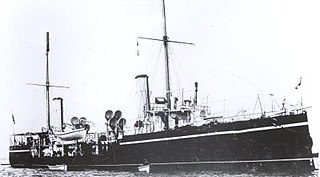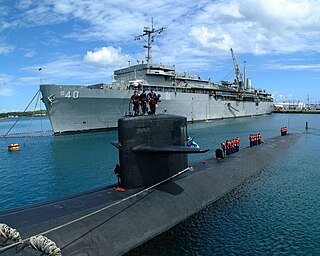
A submarine tender, in British English a submarine depot ship, is a type of depot ship that supplies and supports submarines.

HMS Plymouth was a Royal Navy Rothesay-class frigate. In 1982, Plymouth was one of the first Royal Navy ships to arrive in the South Atlantic during the Falklands War.

The X class was a World War II midget submarine class built for the Royal Navy during 1943–44. It was substantially larger than the original Chariot manned torpedo.

HMS Graph was a German Type VIIC U-boat that the British Royal Navy captured during World War II. Commissioned as U-570 in Nazi Germany's Kriegsmarine in mid-1941, she was attacked and captured on her first patrol.
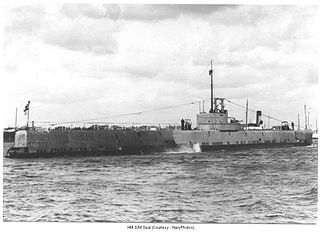
HMS Seal was one of six Grampus-class mine-laying submarines of the Royal Navy. She served in the Second World War and was captured by the Kriegsmarine and taken into German service as UB, one of several captured subs. She was the only submarine the Germans captured at sea during World War II. Her capture allowed the Germans to correct a critical fault in their U-boat torpedoes.
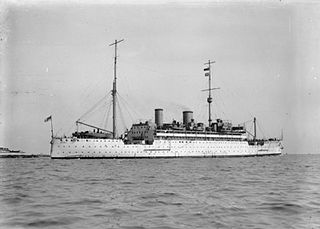
HMS Medway was the first purpose-built submarine depot ship constructed for the Royal Navy. She was built by Vickers Armstrong at Barrow-in-Furness during the late 1920s. The ship served on the China Station before the Second World War and was transferred to Egypt in early 1940. Ordered to evacuate Alexandria in the face of the German advance after the Battle of Gazala in May 1942, Medway sailed for Lebanon at the end of June, escorted by a light cruiser and seven destroyers. Her strong escort could not protect her; on 30 June a German submarine torpedoed and sank her.

HMS Samphire was a Flower-class corvette that served in the Royal Navy.

SMS Wiesbaden was a light cruiser of the Wiesbaden class built for the Imperial German Navy. She had one sister ship, SMS Frankfurt; the ships were very similar to the previous Karlsruhe-class cruisers. The ship was laid down in 1913, launched in January 1915, and completed by August 1915. Armed with eight 15 cm SK L/45 guns, Wiesbaden had a top speed of 27.5 knots and displaced 6,601 t at full load.
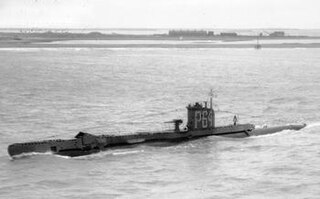
HMS Vandal (P64) was a Royal Navy U-class submarine built by Vickers-Armstrong at Barrow-in-Furness, yard number 838. The submarine had the shortest career of any Royal Navy submarine, being lost with all 37 onboard just four days after commissioning.

SM U-27 was a German Type U-27 U-boat built for service in the Imperial German Navy. She was launched on 14 July 1913, and commissioned on 8 May 1914 with Kapitänleutnant Bernd Wegener in command.

HMS L4 was a L-class submarine built for the Royal Navy during World War I. The boat survived the war and was sold for scrap in 1934.
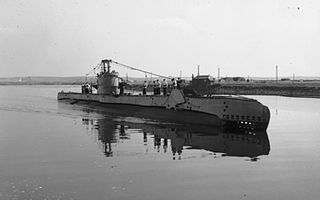
HMS Sirdar was an S-class submarine built for the Royal Navy during the Second World War, and part of the Third Group built of that class. She was built by Scotts, of Greenock and launched on 26 March 1943.
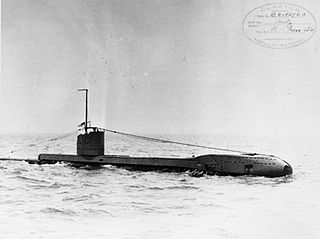
HMS Unity was a U-class submarine, of the first group of that class constructed for the Royal Navy. The submarine entered service in 1938 and performed war patrols during the Second World War. On 29 April 1940, Unity was accidentally rammed and sunk in Blyth, Northumberland's harbour.

HMS Vulcan was a British torpedo boat depot ship launched in 1889, later converted to a submarine tender in 1908-09. As a training hulk, she was renamed HMS Defiance III in 1931 and used for training at Torpoint, Cornwall. She was scrapped in Belgium in 1955.

HMS Porcupine was a P-class destroyer built by Vickers Armstrong on the River Tyne. She was ordered on 20 October 1939, laid down on 26 December 1939 and launched on 10 June 1941. She was commissioned on 31 August 1942, but had a relatively short active career. She was torpedoed in 1942 but salvaged and not finally broken up until 1947.

HMS Elfin was a torpedo recovery vessel built for the Royal Navy. She was built by J. Samuel White & Company, East Cowes, Isle of Wight, was launched on 20 November 1933 and commissioned on 16 January 1934. She was builder's number 1754. Her home port was the Navy's torpedo trials establishment HMS Vernon, and she was based at Portland. A sistership, Redwing, was constructed under builder's number 1753 and was stationed at HMS Defiance, Devonport. Elfin was renamed Nettle during the Second World War, and was later sold for scrapping. She survived in mercantile service, and has been preserved.

HMS Ambrose was a steamship that was built for in 1903 as a passenger liner. The Booth Steam Ship Company ran her scheduled on services between Liverpool and Brazil until the First World War.

HMS Viscount was a V-class destroyer of the British Royal Navy that saw service in the final months of World War I and in World War II.
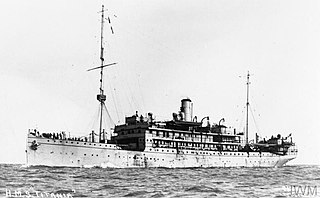
HMS Titania was a Royal Navy submarine depot ship. Most of those that saw service in the First World War were scrapped in the 1930s. Titania, however, saw service in the Second World War. She was scrapped at Faslane, Scotland, in September 1949.













